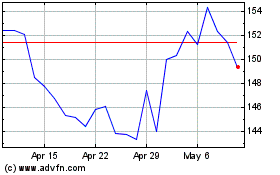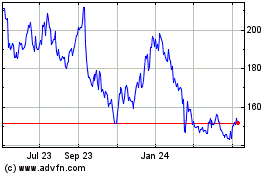−Preclinical Proof of Concept for Oral Delivery
Achieved, Demonstrating Robust, Dose-Dependent Silencing of
Liver-Expressed Target in Rodents, with Durability Profile Similar
to Subcutaneous Administration –
− Company Also Reports on New Advances in CNS
and Ocular Delivery, Demonstrating Durable and Efficacious Target
Silencing in Rodents and Non-Human Primates, with Favorable Profile
Compared with Antisense Oligonucleotides (ASOs) –
Alnylam Pharmaceuticals, Inc. (Nasdaq: ALNY), the leading RNAi
therapeutics company, announced today new advances in its RNAi
therapeutics platform, including preclinical results demonstrating
oral delivery of GalNAc-conjugated small interfering RNAs (siRNAs)
– the molecules that mediate RNAi – directed to a liver target.
Oral delivery could broaden the clinical and commercial
opportunities for RNAi therapeutics, which are currently
administered with intravenous or subcutaneous dose administration.
The results were presented at the 3rd International Conference on
the Long and the Short of Non-Coding RNAs being held June 18-23 in
Crete, Greece. The Company also reported on further progress on
central nervous system (CNS) and ocular delivery of novel siRNA
conjugates.
“These new preclinical data are the first demonstration of
functional delivery of GalNAc-siRNA conjugates via the oral route
of administration, representing an important step forward in
potentially advancing and expanding the clinical and commercial
potential of RNAi therapeutics. Since oral delivery of
GalNAc-conjugate siRNAs was achieved with use of a proprietary
formulation containing a permeation enhancer, we believe that this
approach can be applied to existing and future pipeline
liver-directed programs, potentially creating a relatively
near-term opportunity for Alnylam,” said Kevin Fitzgerald, Ph.D.,
Senior Vice President and Chief Scientific Officer of Alnylam. “We
are equally excited to continue advancing our efforts focused on
CNS and ocular delivery achieving highly durable responses, while
also demonstrating favorable silencing activity of our CNS-targeted
conjugate siRNA as compared to an ASO. Our CNS and ocular RNAi
therapeutic programs are being advanced through our recently
announced collaboration with Regeneron.”
Preclinical studies were performed to investigate the potential
for oral administration of investigational RNAi therapeutics.
Robust and durable messenger RNA (mRNA) silencing was observed in
mice for a GalNAc-conjugated siRNA targeting Factor 12 (F12) with a
proprietary formulation containing a permeation enhancer and
delivered via oral gavage. The knockdown effect was sustained for
over 40 days with a durability profile on par with that achieved
via subcutaneous administration. Knockdown was dose-dependent and
required the presence of the GalNAc conjugate and the formulation
containing a permeation enhancer. Approximately 90 percent
knockdown was observed upon administration of three oral doses at 3
mg/kg.
Additional data on CNS delivery of RNAi therapeutics were also
presented. In rat studies, a head to head comparison of silencing
activity of an siRNA and a previously reported antisense
oligonucleotide (ASO) targeting human superoxide dismutase 1
(hSOD1) was performed in a transgenic model expressing hSOD1. A
single intrathecal injection of a hSOD1-targeted siRNA resulted in
greater silencing activity as compared to its ASO counterpart
across all key anatomical regions of the brain and spinal cord.
Specifically, when dosed at 0.9 mg and measured at Day 7, the
hSOD1-targeted siRNA achieved superior silencing across all regions
of the spine and brain, with mean silencing from 85-88 percent and
64-75 percent, respectively. In contrast, the corresponding ASO
targeting hSOD1 achieved a markedly reduced level of silencing of
68-72 percent in the spine and 25-43 percent in the brain. In
additional studies at a lower dose of 0.45 mg and with measurements
at Day 28, the siRNA targeting hSOD1 achieved mean silencing
between 67-87 percent in the spine while markedly reduced levels of
silencing of 28-44 percent were observed for the ASO targeting
hSOD1.
Finally, results on ocular delivery of RNAi therapeutics were
also presented. Intravitreal administration of a conjugated siRNA
targeting mouse transthyretin (TTR) demonstrated a dose-dependent
and sustained knockdown of TTR, with maximal (greater than 95
percent) suppression achieved at doses as low as 15 micrograms per
eye and lasting up to Day 135 post a single injection. Similarly, a
single low intravitreal dose of a siRNA conjugate targeting human
TTR resulted in virtually complete knockdown of TTR protein in the
NHP eye, with effects lasting for at least three months.
To view the results presented by Alnylam at the 3rd
International Conference on the Long and the Short of Non-Coding
RNAs, please visit www.alnylam.com/capella.
About RNAi
RNAi (RNA interference) is a natural cellular process of gene
silencing that represents one of the most promising and rapidly
advancing frontiers in biology and drug development today. Its
discovery has been heralded as “a major scientific breakthrough
that happens once every decade or so,” and was recognized with the
award of the 2006 Nobel Prize for Physiology or Medicine. By
harnessing the natural biological process of RNAi occurring in our
cells, a new class of medicines, known as RNAi therapeutics, is now
a reality. Small interfering RNA (siRNA), the molecules that
mediate RNAi and comprise Alnylam's RNAi therapeutic platform,
function upstream of today’s medicines by potently silencing
messenger RNA (mRNA) – the genetic precursors – that encode for
disease-causing proteins, thus preventing them from being made.
This is a revolutionary approach with the potential to transform
the care of patients with genetic and other diseases.
About Alnylam Pharmaceuticals
Alnylam (Nasdaq: ALNY) is leading the translation of RNA
interference (RNAi) into a new class of innovative medicines with
the potential to transform the lives of people afflicted with rare
genetic, cardio-metabolic, hepatic infectious, and central nervous
system/ocular diseases. Based on Nobel Prizewinning science, RNAi
therapeutics represent a powerful, clinically validated approach
for the treatment of diseases with high unmet need. ONPATTRO®
(patisiran) is the first-ever RNAi therapeutic approved by the U.S.
FDA for the treatment of the polyneuropathy of hereditary
transthyretin-mediated (hATTR) amyloidosis in adults and by the EMA
for the treatment of hATTR amyloidosis in adults with stage 1 or
stage 2 polyneuropathy. Alnylam has a deep pipeline of
investigational medicines, including five product candidates in
Phase 3 studies and one in registration. Looking forward, Alnylam
will continue to execute on its "Alnylam 2020" strategy of building
a multi-product, commercial-stage biopharmaceutical company with a
sustainable pipeline of RNAi-based medicines to address the needs
of patients who have limited or inadequate treatment options.
Headquartered in Cambridge, MA, Alnylam employs over 1,200 people
worldwide. For more information about our people, science and
pipeline, please visit www.alnylam.com and engage with us on
Twitter at @Alnylam or on LinkedIn.
Alnylam Forward Looking Statements
Various statements in this release concerning Alnylam's future
expectations, plans and prospects, including, without limitation,
Alnylam's views with respect to the potential broadened clinical
and commercial opportunity for oral delivery of RNAi therapeutics
directed to liver targets, relative to the opportunity for
intravenous and subcutaneous delivery of such therapeutics, the
anticipated durability of such RNAi therapeutics administered by
oral delivery, and the continued advancement of Alnylam’s efforts
focused on CNS and ocular delivery of investigational RNAi
therapeutics in preclinical models, and expectations regarding
"Alnylam 2020" guidance for the advancement and commercialization
of RNAi therapeutics, constitute forward-looking statements for the
purposes of the safe harbor provisions under The Private Securities
Litigation Reform Act of 1995. Actual results and future plans may
differ materially from those indicated by these forward-looking
statements as a result of various important risks, uncertainties
and other factors, including, without limitation, Alnylam's ability
to discover and develop novel drug candidates and delivery
approaches, successfully demonstrate the efficacy and safety of its
product candidates, the pre-clinical and clinical results for its
product candidates, which may not be replicated or continue to
occur in other subjects or in additional studies or otherwise
support further development of product candidates for a specified
indication or at all, actions or advice of regulatory agencies,
which may affect the design, initiation, timing, continuation
and/or progress of clinical trials or result in the need for
additional pre-clinical and/or clinical testing, delays,
interruptions or failures in the manufacture and supply of its
product candidates, obtaining, maintaining and protecting
intellectual property, Alnylam's ability to enforce its
intellectual property rights against third parties and defend its
patent portfolio against challenges from third parties, obtaining
and maintaining regulatory approval, pricing and reimbursement for
products, progress in establishing a commercial and ex-United
States infrastructure, successfully launching, marketing and
selling its approved products globally, Alnylam’s ability to
successfully expand the indication for ONPATTRO in the future,
competition from others using technology similar to Alnylam's and
others developing products for similar uses, Alnylam's ability to
manage its growth and operating expenses, obtain additional funding
to support its business activities, and establish and maintain
strategic business alliances and new business initiatives,
Alnylam's dependence on third parties for development, manufacture
and distribution of products, the outcome of litigation, the risk
of government investigations, and unexpected expenditures, as well
as those risks more fully discussed in the "Risk Factors" filed
with Alnylam's most recent Quarterly Report on Form 10-Q filed with
the Securities and Exchange Commission (SEC) and in other filings
that Alnylam makes with the SEC. In addition, any forward-looking
statements represent Alnylam's views only as of today and should
not be relied upon as representing its views as of any subsequent
date. Alnylam explicitly disclaims any obligation, except to the
extent required by law, to update any forward-looking
statements.
View source
version on businesswire.com: https://www.businesswire.com/news/home/20190621005157/en/
Alnylam Pharmaceuticals, Inc. Christine Regan Lindenboom
(Investors and Media)
617-682-4340 or
Josh Brodsky (Investors) 617-551-8276
Alnylam Pharmaceuticals (NASDAQ:ALNY)
Historical Stock Chart
From Mar 2024 to Apr 2024

Alnylam Pharmaceuticals (NASDAQ:ALNY)
Historical Stock Chart
From Apr 2023 to Apr 2024
